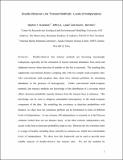Double-observer line transect methods : levels of independence
Abstract
Double-observer line transect methods are becoming increasingly widespread, especially for the estimation of marine mammal abundance from aerial and shipboard surveys when detection of animals on the line is uncertain. The resulting data supplement conventional distance sampling data with two-sample mark–recapture data. Like conventional mark–recapture data, these have inherent problems for estimating abundance in the presence of heterogeneity. Unlike conventional mark–recapture methods, line transect methods use knowledge of the distribution of a covariate, which affects detection probability (namely, distance from the transect line) in inference. This knowledge can be used to diagnose unmodeled heterogeneity in the mark–recapture component of the data. By modeling the covariance in detection probabilities with distance, we show how the estimation problem can be formulated in terms of different levels of independence. At one extreme, full independence is assumed, as in the Petersen estimator (which does not use distance data); at the other extreme, independence only occurs in the limit as detection probability tends to one. Between the two extremes, there is a range of models, including those currently in common use, which have intermediate levels of independence. We show how this framework can be used to provide more reliable analysis of double-observer line transect data. We test the methods by simulation, and by analysis of a dataset for which true abundance is known. We illustrate the approach through analysis of minke whale sightings data from the North Sea and adjacent waters.
Citation
Buckland , S T , Laake , J L & Borchers , D L 2010 , ' Double-observer line transect methods : levels of independence ' , Biometrics , vol. 66 , no. 1 , pp. 169-177 . https://doi.org/10.1111/j.1541-0420.2009.01239.x
Publication
Biometrics
Status
Peer reviewed
ISSN
0006-341XType
Journal article
Collections
Items in the St Andrews Research Repository are protected by copyright, with all rights reserved, unless otherwise indicated.

